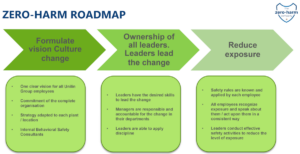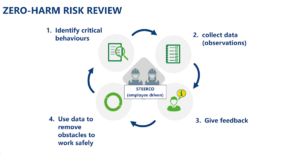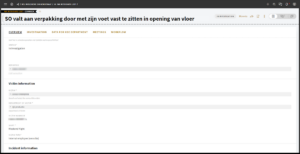How Unified EHS Software Supports Safety Performance at Unilin
As we gear up for SafetyWorX 2024, let’s take a moment to relive the highlights from last year’s edition, when Unilin’s Safety Expert Geoffrey Breyne shared how TenForce supports Unilin’s zero-harm policy, offering insights into his experience and unveiling a practical three-step roadmap for success.
Introducing a zero-harm policy at Unilin
Unilin, a leading player in the manufacturing industry with 105 global locations and 8600 employees, offers a broad range of products, including laminate flooring, engineered wood, vinyl floors, and carpeting.
With a commitment to zero-harm, well-being, and lifelong learning, their employees live by the motto “a home away from home.” In 2019, they introduced a zero-harm policy that would create a positive and caring culture where safety became an inherent part of daily operations.
The monumental task was made easier with a three-step roadmap:
- Formulating a vision for culture change: create a clear vision, secure commitment from the entire organization, and implement tailored strategies at each location.
- Making leadership the owners of culture change: provide leaders with the necessary skills, responsibility, and authority to lead the change in their departments.
- Reducing exposure to hazards: teach all employees how to apply safety rules, recognize hazards, and address them in a consistent way. Conduct safety activities to minimize exposure to hazards.

Step 1: Laying the groundwork for culture change
To make their vision a reality, Unilin needed commitment from everyone. So, setting clear expectations for the various roles was vital:
Employees should:
- Follow safety rules, wear PPE, and maintain a tidy workplace
- Spot risks, speak up, and take proactive measures
- Give positive feedback for safe practices and welcome constructive feedback for unsafe behavior
- Celebrate safety achievements
Team leaders should:
- Include safety in all meetings
- Coach workers on safe behavior
- Manage risks, investigate incidents, and share lessons learned
- Ensure workers have the required knowledge and skills
- Celebrate safety achievements
Senior managers should:
- Promote and embody the safety vision
- Include safety in decision-making, management strategies, and KPIs
- Investigate SIF (Serious Injury or Fatality) incidents
- Actively take part in safety initiatives
- Provide time and resources for safe work practices
- Hold everybody accountable for the safety vision
Step 2: Equip leaders to lead the change
With expectations set, special attention was given to the team leaders to make sure they had the skills and resources needed to spearhead the new policy. A tailored training program laid out the best practices for implementing the zero-harm policy, including:
- Going beyond managerial roles to become promoters of a safety-centric culture.
- Leading by example.
- Translating commitment into proactive actions.
- Opening up transparent dialogue about safety.
- Fostering teamwork across departments.
- Giving positive reinforcement and constructive feedback.
- Instilling a culture of accountability and safety ownership.
Step 3. Reduce hazards
Next came the actual safety program. This centered around five key elements:
- Safety contact: A feedback moment provided during tasks to identify safe actions or potential risks and analyze task performance.
- Safety briefing: Pre-task briefings conducted to discuss associated hazards, decide control measures, and establish when it is necessary to stop.
- Life-saving rules: Ground rules governing activities with the highest risk, such as Lock out/tag out (LOTO), handling rolling materials, and working at heights.
- Zero-harm risk reviews: An employee-driven mechanism for making observations, identifying critical behaviors, and providing immediate feedback.
- Safety communications: Messages or conversations such as toolbox meetings, posters, safety training, safety events, safety campaigns, and safety timeouts.

How TenForce’s EHS software supports Unilin’s zero-harm goal
Unilin was on the lookout for a digital solution to streamline and standardize HSE-related data collection across their global operations. Not only this – they also needed a management tool capable of automated action management and robust reporting. Flexibility was key, and it had to be a tool ready to tackle future projects.

That’s where TenForce came in. Since 2019 we’ve been supporting Unilin in achieving its zero-harm goals through three key areas:
Incident management
- TenForce records events like work accidents, first aid incidents, and hazards.
- It documents investigations, defines corrective actions, communicates with stakeholders, and follows up.
- It visualizes data through an integration with PowerBI.
Zero-harm tools
- TenForce registers safety contacts and job safety briefings.
- It conducts a task analysis of life-saving rules.
- Unilin utilizes a mobile application for zero-harm risk reviews in the field
- TenForce structures the work, collects data, and provides a validation flow.
Work permits
- TenForce structures work preparation, including risk identification and evaluation.
- It performs last-minute risk analysis, permit briefing, and post-work completion follow-up.
- It integrates with the fire protection state for hot work.
